Golden Road
RSP 11345
Grower: Happy Valley
Summary
Golden Road (RSP11345/Happy Valley) is a genetic Type I plant and its genetics appear rare. The sample's closest relative in the database is Durban Poison #1 (RSP11013/DigiPath Labs) and it is a potential cousin. The heterozygosity rate is 1.1% which is average (52.0 percentile).
General Information
- Accession Date
- October 17, 2019
- Reported Plant Sex
- Female
- Report Type
- StrainSEEK v2 3.2Mb
- DNA Extracted From
- Stem
The strain rarity visualization shows how distant the strain is from the other cultivars in the Kannapedia database. The y-axis represents genetic distance, getting farther as you go up. The width of the visualization at any position along the y-axis shows how many strains there are in the database at that genetic distance. So, a common strain will have a more bottom-heavy shape, while uncommon and rare cultivars will have a visualization that is generally shifted towards the top.
Chemical Information
Cannabinoid and terpenoid information provided by the grower.
Cannabinoids
No information provided.
Terpenoids
No information provided.
Genetic Information
- Plant Type
- Type I
File Downloads
The bell curve in the heterozygosity visualization shows the distribution of heterozygosity levels for cannabis cultivars in the Kannapedia database. The green line shows where this particular strain fits within the distribution. Heterozygosity is associated with heterosis (aka hybrid vigor) but also leads to the production of more variable offspring. When plants have two genetically different parents, heterozygosity levels will be higher than if it has been inbred or backcrossed repeatedly.
The ratio of reads mapped to Y-contigs to reads mapped to the whole Cannabis genome (Y-ratios) has been demonstrated to be strongly correlated with plant sex typing. This plot shows the distribution of Y-ratios for all samples in our database which were sequenced with the same method (panel or WGS) as this sample and where this sample falls in the distribution.
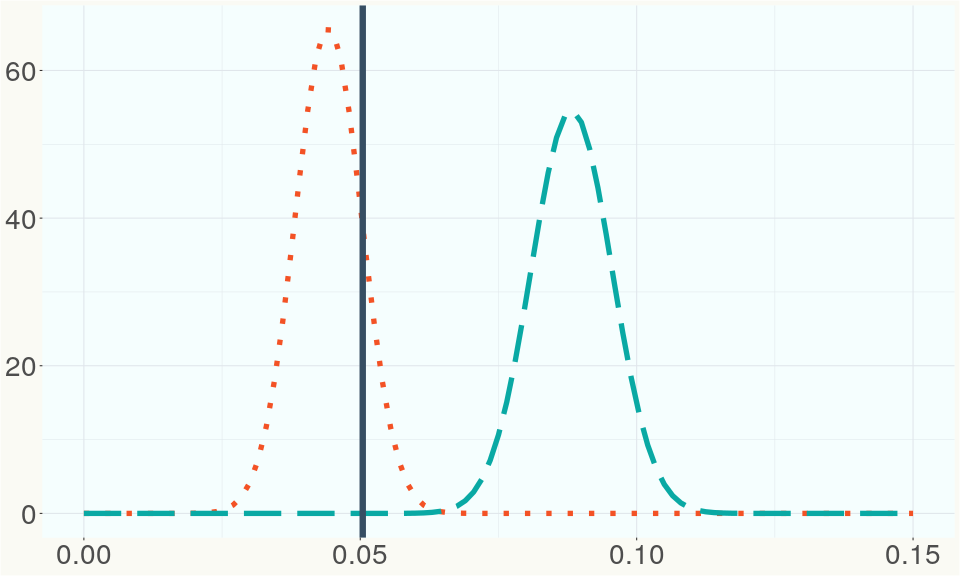
This chart represents the Illumina sequence coverage over the Bt/Bd allele. These are the three regions in the cannabis genome that impact THCA, CBDA, CBGA production. Coverage over the Active CBDAS gene is highly correlated with Type II and Type III plants as described by Etienne de Meijer. Coverage over the THCA gene is highly correlated with Type I and Type II plants but is anti-correlated with Type III plants. Type I plants require coverage over the inactive CBDA loci and no coverage over the Active CBDA gene. Lack of coverage over the Active CBDA and Active THCA allele are presumed to be Type IV plants (CBGA dominant). While deletions of entire THCAS and CBDAS genes are the most common Bt:Bd alleles observed, it is possible to have plants with these genes where functional expression of the enzyme is disrupted by deactivating point mutations (Kojoma et al. 2006).
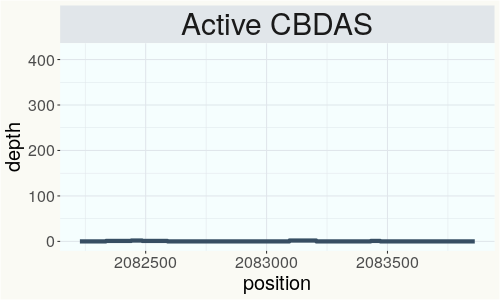
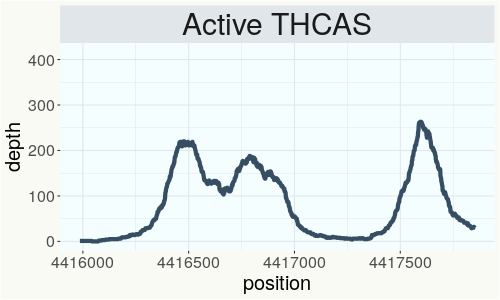
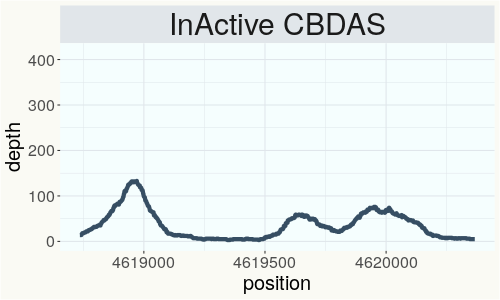
This chart represents the Illumina sequence coverage over the CBCA synthase gene.
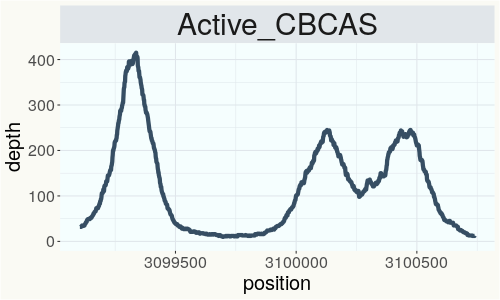
Variants (THCAS, CBDAS, and CBCAS)
Variants (Select Genes of Interest)
| PKSG-2a | c.67T>A | p.Phe23Ile | missense variant | moderate | contig700 | 1945567 | A/T | |
| PKSG-2a | c.31A>T | p.Thr11Ser | missense variant | moderate | contig700 | 1945603 | T/A | |
| PKSG-2b | c.1152T>A | p.Asn384Lys | missense variant | moderate | contig700 | 1950486 | A/T | |
| PKSG-2b | c.1132C>G | p.Leu378Val | missense variant | moderate | contig700 | 1950506 | G/C |
|
| PKSG-2b | c.1117A>G | p.Ile373Val | missense variant | moderate | contig700 | 1950521 | T/C | |
| PKSG-2b | c.774G>A | p.Met258Ile | missense variant | moderate | contig700 | 1950864 | C/T | |
| PKSG-2b | c.31A>T | p.Thr11Ser | missense variant | moderate | contig700 | 1951851 | T/A | |
| PKSG-4b |
c.535_545del |
p.Ile179fs | frameshift variant | high | contig700 | 2721127 |
CCCCACTCCAAT |
|
| PKSG-4b | c.523C>T | p.His175Tyr | missense variant | moderate | contig700 | 2721150 | G/A | |
| PKSG-4b | c.489delT | p.Phe163fs | frameshift variant | high | contig700 | 2721183 | CA/C | |
| PKSG-4b |
c.353_354ins |
p.Gly119fs | frameshift variant | high | contig700 | 2721319 | T/TGG |
|
| DXR-2 | c.1319T>C | p.Ile440Thr | missense variant | moderate | contig380 | 285250 | A/G |
|
| aPT4 | c.35A>C | p.Gln12Pro | missense variant | moderate | contig121 | 2828691 | A/C |
|
| aPT4 | c.97T>C | p.Tyr33His | missense variant | moderate | contig121 | 2828753 | T/C |
|
| aPT4 | c.153A>C | p.Lys51Asn | missense variant | moderate | contig121 | 2828809 | A/C |
|
| aPT4 | c.216A>T | p.Lys72Asn | missense variant | moderate | contig121 | 2828872 | A/T |
|
| aPT4 | c.775delT | p.Tyr259fs | frameshift variant | high | contig121 | 2831380 | AT/A |
|
| aPT4 | c.1168T>C | p.Tyr390His | missense variant | moderate | contig121 | 2833503 | T/C |
|
| aPT1 | c.406A>G | p.Ile136Val | missense variant | moderate | contig121 | 2839605 | A/G | |
| aPT1 | c.629C>T | p.Thr210Ile | missense variant | moderate | contig121 | 2840237 | C/T | |
| HDS-2 |
c.82_93delGT |
p.Val28_Thr3 |
conservative inframe deletion | moderate | contig95 | 1989748 |
CGTAACCGGAAC |
|
| HDS-2 | c.127T>G | p.Ser43Ala | missense variant | moderate | contig95 | 1989794 | T/G |
|
Nearest genetic relatives (All Samples)
- 0.204 Durban Poison #1 (RSP11013)
- 0.214 Blueberry Cheesecake (RSP10684)
- 0.218 Ringo s Angel (RSP10085)
- 0.221 Doug s Varin (RSP11243)
- 0.221 Durban Poison #1 (RSP10996)
- 0.225 UnObtanium (RSP11611)
- 0.226 Trump x Trump (RSP11466)
- 0.227 Domnesia (RSP11184)
- 0.230 Electra (RSP11366)
- 0.231 RKM-2018-004 (RSP11095)
- 0.232 RKM-2018-033 (RSP11125)
- 0.232 JABBA S STASH (RSP11348)
- 0.233 JL Cross 26 (RSP11527)
- 0.234 Joy (RSP11380)
- 0.234 RKM-2018-004 (RSP11096)
- 0.238 Rest (RSP11377)
- 0.240 RKM-2018-010 (RSP11101)
- 0.241 CBG Berry (RSP11446)
- 0.244 JL X NSPM1 7 (RSP11469)
- 0.246 Durban Poison (RSP10998)
Most genetically distant strains (All Samples)
- 0.421 Cherry Blossom (RSP11318)
- 0.411 Cherry Blossom (RSP11317)
- 0.411 80E (RSP11213)
- 0.409 Cherry Blossom (RSP11306)
- 0.403 Cherry Blossom (RSP11322)
- 0.403 Cherry Blossom (RSP11333)
- 0.403 Cherry Blossom (RSP11323)
- 0.393 Cherry Blossom (RSP11324)
- 0.390 BagSeed (RSP12627)
- 0.387 Wife (RSP11148)
- 0.384 CS (RSP11208)
- 0.384 Cherry Blossom (RSP11325)
- 0.381 CS Indica (RSP11658)
- 0.380 Chematonic -Cannatonic x Chemdawg- (RSP11394)
- 0.379 Cherry Blossom (RSP11330)
- 0.379 Cherry Blossom (RSP11308)
- 0.377 Queen Dream CBG (RSP11287)
- 0.377 Cherry Blossom (RSP11335)
- 0.376 Cherry Blossom (RSP11326)
- 0.375 80E (RSP11211)
Nearest genetic relative in Phylos dataset
- Overlapping SNPs:
- 64
- Concordance:
- 43
Nearest genetic relative in Lynch dataset
- Overlapping SNPs:
- 6
- Concordance:
- 6
Blockchain Registration Information
- Transaction ID
-
1fc13f1fa36fbf4f
83751164dc823c02 d7948bdc570331bf 98682802f416d265 - Stamping Certificate
- Download PDF (850.5 KB)
- SHASUM Hash
-
ef8a31b7d50a145b317b25fc1ded075f d513ad6d95bfb21e cafc53d67b66dfa9